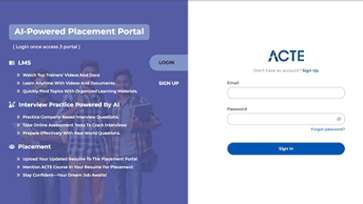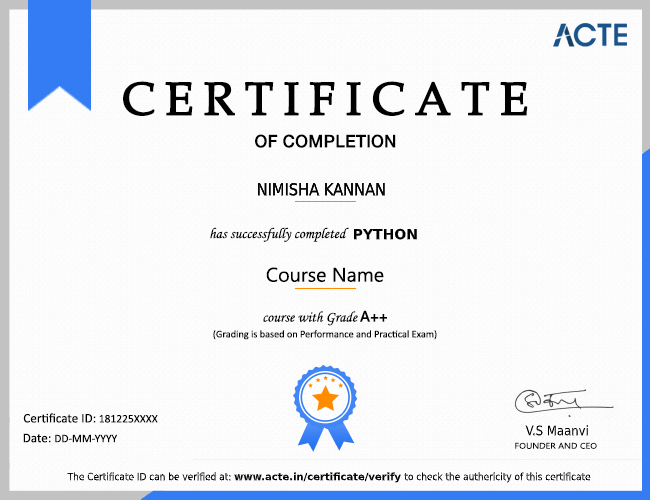OBIEE is a BI solution for Oracle Company to collect, store and analyse the data for corporate reporting, dashboards, scorecards and ad hoc analysis. Oracle Business Intelligence Enterprise Edition. OBIEE is a multi-server architecture that leverages Siebel Analytics to segregate information access and analysis display. You will learn the data storage architecture, the design, the aggregation, OLAP, OLTP, ETL, the indexing strategy, performance tuning, and much more in this course. Current trends in the industry indicate that OBIEE's professionals are in huge demand. Given the growth rate in the industry, this would be a wise career choice. With more experience, the salary scale is only increasing and chances in this field are never dear. ACTE offers the best OBIEE Course in Pune with highly qualified experts. We are aware of the needs of the industry and we offer more practical OBIEE training.
Additional Info
Future scope in OBIEE:
One of the benefits of using the cloud is that releases are more frequent (depending on how you look at them). Furthermore, they are automatic, so you don't have to worry about installing any updates or new versions. Oracle will not have all of the unique features of its on-premises EPM solution. However, this does not appear to be the case for OBIEE according to Oracle, when an on-premises version is scheduled, the most recent cloud release features are included. These are Kscope18's OBIEE releases. Business Intelligence has demonstrated steady growth in livelihood chances in the past couple of decades. Organizations are searching for information analysts or business analysts to fill places such as project managers and architects. Business Intelligence analysts operate to help build knowledge jobs, of BI tools, and also to aid in presentations of BI solutions.
Project managers are accountable for identifying business development areas and creating appropriate solutions to coordinate with internal divisions to deploy data warehouses, software, and portal sites. BI professionals draw on wages that are attractive with lots of expansion opportunities, both in India as well as overseas.
Job Roles and Responsibilities in OBIEE :
The role of an OBIEE Developer involves making use of OBIEE technology to help organizations collect, refine, and manage data from various sources that are crucial to important decision making. The developer must understand the context in which the business operates and the overall business requirements. They can then offer ideas and suggestions to improve business processes, anticipate future issues and developments. This makes OBIEE Developers key players in the planning, analytical, and strategic decisions within an organization.
- OBIEE design, development, delivery, and upkeep.
- Project management with the usage of the Oracle platform.
- System environment installation and configuration.
- OBIEE report development and migration.
- Analyzing business problems and turning them into solutions.
- Data models, access structures, and reports are created.
- Creating BI data models in collaboration with other teams using Agile.
- Designing functional and technological specifications.
- Managing code and design reviews, as well as developing technical presentations.
- They next concentrate on creating plans for the OBIEE tool as well as deploying, installing, and/or upgrading BI tools as needed.
- They handle BI projects using the Oracle platform and are in charge of BI infrastructure maintenance.
- They also create OBIEE reports, execute test plans for the BI infrastructure, and give assistance to OBI team members, SMEs, and testers by building high BI data models to meet reporting demands.
Advantages of OBIEE:
The advantages of OBIEE are as follows:
Visualization:- Visualization and types of displays used in OBIEE, providing the interactive dashboard looks bright in the diagram above, are among OBIEE's best advantages.
Scratch Report Creation:- OBIEE provides a scratch reporting feature so that users can generate reports from scratch in any feature.
User Friendly:- The report is very easy to develop and easy to use. To create an OBIEE report, you can just drag and drop columns.
Flash Report:- OBIEE allows us to create flames that enhance the interactive dashboard's beauty.
Modified report:- OBIEE allows us to create an ad hoc reporting template.
Main data sources integration:- OBIEE is closely linked to key data sources such as Microsoft Office or third-party vendors.
What Does the Future of Business Intelligence Look Like?
The latest BI trends, like any other technology, will continue to evolve. From the early days when BI was confined to spreadsheets bursting with numbers, today, technology allows for insightful visualization and immediate action. Today, business intelligence (BI) provides businesses with new and innovative methods to enhance efficiency, generate profitability, and better understand their consumers. As technology evolves at the speed of light, the future of business intelligence appears bright. However, in order to derive true benefit from BI, it is necessary to be informed of emerging trends, understand whether and how they may be implemented, and have a plan in place to embrace technology across the board.
1. Governance of Data:- As data privacy and security requirements become increasingly severe, data quality management has become critical for business excellence. In the next few years, companies will make persistent attempts to classify data and understand where it comes from, who has access to it, how people use it, and how long they may retain it. In the world of business intelligence, data governance will become a major issue for both large and small businesses. This will also be driven by the rising quantity and complexity of data sources and data kinds required to support analytics projects. A solid data governance approach will not only help increase ROI from B, but it will also help improve ROI from C. It will also make it possible to strike a good balance between data consistency and openness. This, in turn, will lay the groundwork for accurate, ethical, and evidence-based decision-making.
2. BI self-service:- As corporate users become more technologically aware, they expect to have access to the data they need to accomplish their jobs successfully at any time and from any location. They want to be able to address problems on their own — without relying on an analytics team. Using consolidated data from throughout the business, users want to drive value with the tool of their choosing. Although self-service BI is currently popular, it will become a worldwide standard in the coming years, allowing users to gain the information they need to handle difficult business challenges in a timely manner. It will also aid in the optimization of decision-making capabilities across companies while providing users with a single version of the truth.
3.Prescriptive Analytics:- Although predictive analytics has been an essential part of BI, allowing companies to extract information from existing data sets in order to estimate future possibilities, prescriptive analytics will become a global component in the next few years. Prescriptive analytics examines data or content to identify what measures must be performed to accomplish a certain goal. By predicting the influence of future actions, businesses will be able to alter them before they are made, enhancing decision-making accuracy.
4. Business Intelligence through Natural Language Processing (NLP):- The rise of NLP is unprecedented as the interaction between people and technology gets increasingly profound. Although smart voice assistants have long used NLP to reply to consumers, companies will also enhance business outcomes in the future years to gain a more substantial competitive edge. In a few years, NLP will be employed not only in customer support, but also in other sectors of business. NLP, for example, will enable less tech-savvy staff to make sense of complex systems and digital tools. It will also make BI-based data more accessible and allow non-technical people to connect to data more easily and rapidly.
5.Business Intelligence-as-a-Service (BIaaS):- As the XaaS paradigm pervades nearly every aspect of business, BI and data analytics will be no exception. Companies who have massive volumes of data but are having difficulties accessing it or extracting insights from it will look towards BI-as-a-Service possibilities. This architecture will provide all of the benefits of a full-fledged, end-to-end BI solution, but with the convenience and simplicity of cloud deployment.
6. Business Intelligence Collaborative and Integrative:- In the next few years, collaborative and integrative BI will become more common. Unlike now, when stand-alone BI solutions must be acquired and installed separately, most corporate systems will include built-in BI capabilities, allowing users to discover insights and make choices without ever leaving the platform. Next-generation BI systems will be designed for larger groups of users and will be increasingly integrated with larger corporate systems. They will continually gather data from the necessary sources, integrate and analyze it, and offer users the necessary insights in real-time. These technologies will also be able to give users notifications.
Characteristics of OBIEE:
OBIEE stands for Oracle Enterprise Intelligence Edition which is the Oracle company's tool for creating interactive reporting and dashboards in the OLAP environment. OBIEE allows the user to provide a strong set of reporting functions, ad-hoc query analyses, dashboards, and scorecards. Compared to web-based service-oriented architecture, OBIEE solutions are cost-efficiency solutions. Many features such as rich visualization, interactive dashboards, animated charting, and innovative search are available in OBIEE Even though the main OBIEE competitors are many important features:
1. The dashboards interactive:- OBIEE offers its users the opportunity to create their interactive dashboards, with good visuals and rich feeling. One of the most important features of OBIEE is the interactive dashboard. I tried to define an interactive dashboard with rich bar graphs and 3D pie chart visualizations. The most important features of OBIEE are the Interactive Dashboards.
2. Enterprise Reporting:- The enterprise reporting feature offers the OBIEE to enable user numbers, reports and Flash reports that are highly formatted.
3. Creating self-service reports:- OBIEE allows users to create their own reports from the ground up. In RPD development, users can begin with a scratch and should create reports themselves. In OBIEE, users are able to create or change interactive reports.
4.Microsoft Office Integration:- Another of OBIEE's key characteristics. In OBIEE the data from Word, PowerPoint, or Excel is used in OBIEE minutes through the Microsoft Office integration.
5. Proactive detection and alerts:- OBIEE provides a powerful engine that relies on business events, almost in real-time. This alert motor informs the customers or stakeholders of the OBIEE reports via a special medium.
6. Activating intelligence:- By transforming business processes into interactive reports and dashboards, OBIEE provides actionable information.
7. Map Visualization:- OBIEE allows the user to view analytical data to different types of maps, such as pie charts, bar charts, etc.
Salary Package of OBIEE:
The national average salary for an Obiee Developer is 5,43,676 in India. Filter by location to see Obiee Developer salaries in your area. Salary estimates are based on 13 salaries submitted anonymously to Glassdoor by Obiee Developer employees. Employees who know about OBIEE receive an average of twenty-five million, typically between ten and ten thousand lakhs per year, and five hundred profile lakhs each year. The top 10% of workers make 30,0 lakhs per year. The highest reported pay offered is 50.0lakhs who know OBIEE. The top 10% of workers make 30,0 lakhs per year. The top 1% earns more than 50.0 lakhs annually.































